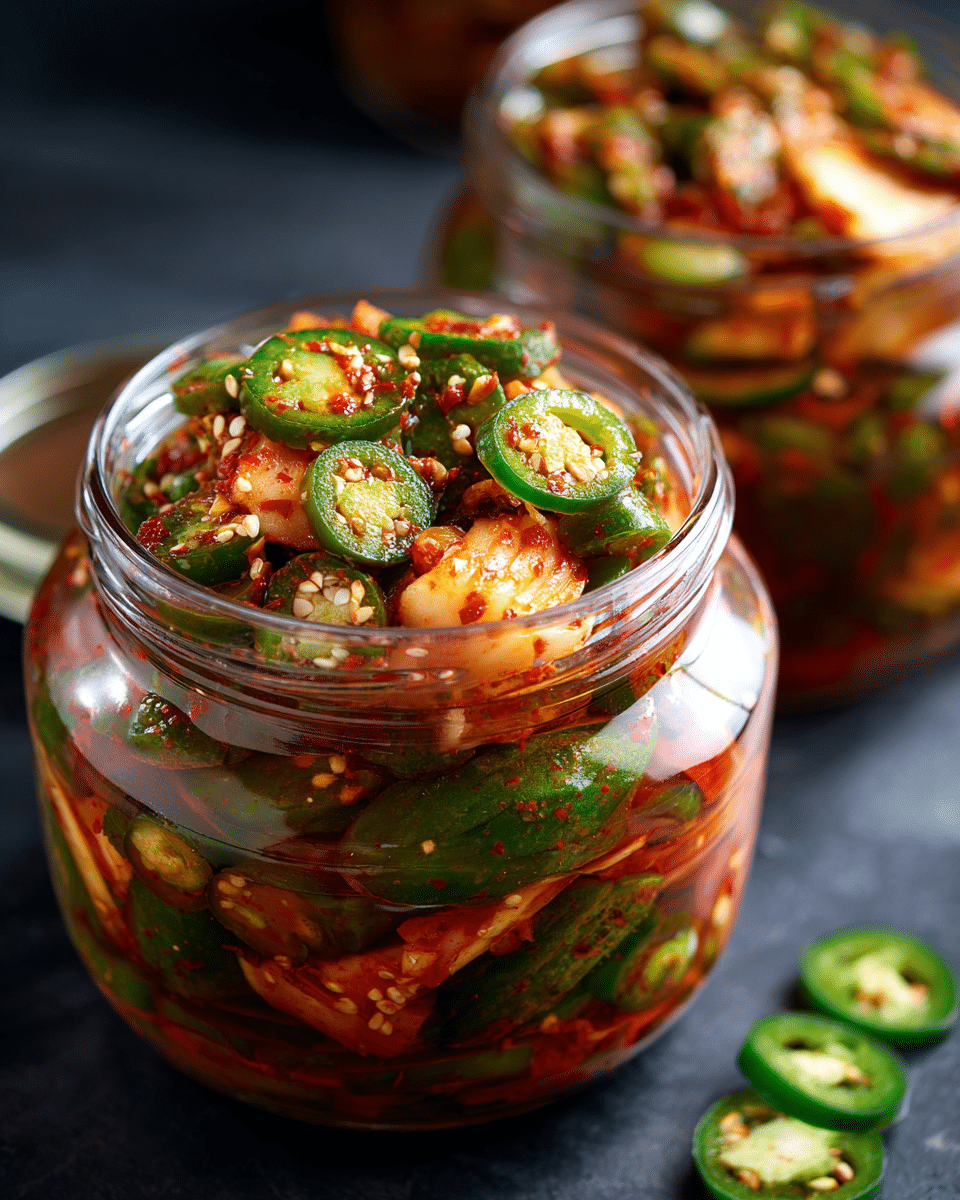Spicy Cucumber Kimchi, known as Oi Kimchi or Oi Sobagi in Korean, is a vibrant and crunchy side dish that bursts with fiery, tangy, and umami-rich flavors. This quick-fermenting kimchi uses crisp cucumbers stuffed with a spicy seasoning mix, offering a refreshing yet bold punch to any meal.
FULL RECIPE
Ingredients
- 6 small Persian cucumbers (or Korean cucumbers)
- 1 tablespoon coarse sea salt (for salting cucumbers)
- 1 tablespoon sea salt (for seasoning paste)
- 2 tablespoons gochugaru (Korean red pepper flakes)
- 1 tablespoon sugar
- 3 cloves garlic, minced
- 1 teaspoon fresh ginger, grated
- 2 green onions, chopped
- 1 medium carrot, julienned
- 1 tablespoon fish sauce (or soy sauce for vegetarian option)
- 1 tablespoon rice vinegar
- 2 tablespoons water
Directions
- Wash cucumbers thoroughly and slice them lengthwise into quarters, leaving one end intact so they stay connected.
- Place cucumbers in a large bowl, sprinkle with 1 tablespoon coarse sea salt, and toss to coat. Let sit for 30 minutes, turning occasionally, to draw out excess moisture.
- Rinse cucumbers under cold water to remove excess salt and gently pat dry.
- In a separate bowl, combine the remaining 1 tablespoon sea salt, gochugaru, sugar, garlic, ginger, green onions, carrot, fish sauce, rice vinegar, and water to form a spicy paste.
- Gently open each cucumber slit and stuff with the seasoning mixture, ensuring even distribution.
- Place stuffed cucumbers in a clean glass container or jar, packing them tightly but without crushing.
- Cover loosely and let ferment at room temperature for 4–6 hours for a quick pickle, or up to 24 hours for more developed flavor.
- Transfer to the refrigerator, where it will continue to ferment slowly. Enjoy within 1–2 weeks for best texture and flavor.
Nutrition Facts
- Calories: 45
- Protein: 1g
- Fat: 0g
- Carbohydrates: 10g
- Fiber: 2g
- Sugars: 4g
- Sodium: 550mg
- Vitamin A: 35% DV
- Vitamin C: 20% DV
- Calcium: 2% DV
- Iron: 3% DV
Origins and Cultural Significance
Spicy Cucumber Kimchi, or Oi Kimchi, holds a cherished place in Korean culinary tradition, particularly as a summertime banchan (side dish). Unlike napa cabbage kimchi, which can require weeks to ferment, cucumber kimchi is often prepared for quicker consumption, allowing families to enjoy its fresh crunch and vibrant flavor within hours or days. It is closely tied to seasonal eating in Korea, where the abundance of crisp cucumbers in summer inspires lighter, refreshing kimchi varieties. Historically, this dish served as a cooling accompaniment to grilled meats, stews, and rice during hot weather, balancing richer foods with its tangy, spicy kick.
Flavor Profile and Texture
The appeal of Spicy Cucumber Kimchi lies in its dynamic interplay of flavors and textures. Each bite offers the immediate crispness of salted cucumbers, followed by a burst of garlicky heat from gochugaru (Korean red pepper flakes) and the umami depth of fish sauce or soy sauce. A hint of sweetness balances the spice, while ginger and vinegar add a clean brightness. Unlike longer-fermented kimchi, which develops sour complexity over time, cucumber kimchi retains a fresh, vegetal note that makes it uniquely refreshing while still delivering the bold, fermented undertones expected from kimchi.
Nutritional Benefits
Cucumber kimchi is a nutrient-packed side dish with a surprisingly low calorie count, making it suitable for those seeking a light yet flavorful accompaniment. Cucumbers are naturally hydrating due to their high water content, while also providing vitamins C and K, potassium, and dietary fiber. The fermentation process introduces probiotics, which support gut health and aid digestion. The addition of garlic and ginger brings antioxidant and anti-inflammatory compounds, while the red pepper flakes provide capsaicin, which can boost metabolism. Overall, it’s a wholesome dish that delivers both taste and wellness benefits.
Common Variations
While the traditional recipe follows a well-loved formula, there are numerous ways to customize Spicy Cucumber Kimchi. For a milder heat, cooks may reduce the amount of gochugaru or blend it with paprika for color without intense spice. Vegan adaptations often replace fish sauce with soy sauce or kelp broth for umami richness. Some households add thinly sliced onions, radish, or bell peppers for extra crunch and flavor complexity. There are also versions where cucumbers are diced into bite-sized pieces instead of stuffed, creating an easy-to-mix salad-style kimchi.
Serving Suggestions
Spicy Cucumber Kimchi can be served in various ways to enhance a meal. As a side dish, it pairs beautifully with Korean barbecue, rice bowls, or noodle dishes, adding a refreshing counterpoint to rich or fatty foods. It also works as a topping for bibimbap, a filling for wraps, or a flavorful garnish for grilled fish. Its bright spice and crunch can elevate simple steamed rice into a satisfying dish, while its acidity helps cut through greasy or heavy textures, making it a versatile addition to any dining table.
Pairing Ideas
Beyond Korean cuisine, cucumber kimchi pairs surprisingly well with other flavor profiles. Its tangy spice complements Mexican-style tacos, grilled seafood, and even roasted poultry. It can also be added to sandwiches, burgers, or flatbreads for a bold twist. For beverages, pairing it with light lagers, sparkling water, or mild herbal teas helps balance the heat, while fruit-forward wines like Riesling or Gewürztraminer can highlight its sweet-spicy notes. In fusion cooking, cucumber kimchi can serve as an unexpected yet harmonious element in dishes from different culinary traditions.
Fermentation and Storage Tips
The fermentation process is the key to developing the signature tang and complexity of cucumber kimchi. For a fresh-tasting version, it can be enjoyed within just a few hours after seasoning, but allowing it to ferment at room temperature for 12–24 hours deepens the flavor. Once refrigerated, it will continue to develop slowly, usually staying at peak quality for 1–2 weeks. To maintain crispness, always use clean utensils when handling kimchi and ensure it remains submerged in its brine to prevent spoilage. Over time, the cucumbers will soften, but the flavor will intensify.
Texture Preservation Secrets
One of the challenges of making cucumber kimchi is keeping the cucumbers crunchy throughout fermentation. Salting them beforehand is essential, as it draws out excess water, preventing sogginess while allowing them to absorb the seasoning better. Using firm, fresh cucumbers, ideally Persian or Korean varieties, also makes a difference. Some cooks add a small amount of vinegar or use ice-cold water rinses after salting to help preserve firmness. Proper storage in airtight containers further slows down the softening process, ensuring a satisfying crunch with every bite.
Health and Dietary Adaptations
Spicy Cucumber Kimchi can easily be adapted to meet various dietary needs. For low-sodium diets, the salt quantity can be reduced, though this may shorten the shelf life. Gluten-free versions can use tamari instead of soy sauce. For those avoiding animal products, swapping fish sauce for a mix of soy sauce and seaweed-infused water keeps the depth of flavor intact. Additionally, those who prefer less heat can reduce the gochugaru and incorporate milder spices or herbs for flavor balance without overpowering spice.
Seasonal and Festive Uses
Though cucumber kimchi is most popular in summer, it can be enjoyed year-round with seasonal variations. In colder months, it provides a refreshing contrast to hearty stews and braised meats. During festive gatherings, it can be served as part of a larger spread of banchan to impress guests with its vibrant color and zesty taste. Its quick preparation time makes it an excellent last-minute dish for holidays, picnics, and potlucks, where it often becomes a conversation starter due to its striking presentation and bold flavor.
Conclusion
Spicy Cucumber Kimchi is a dish that beautifully blends tradition, nutrition, and flavor versatility. Its crunchy texture, lively heat, and tangy undertones make it a standout side dish that complements countless meals. Whether served fresh for a bright, crisp bite or fermented longer for deeper complexity, it brings both cultural richness and culinary excitement to the table.






